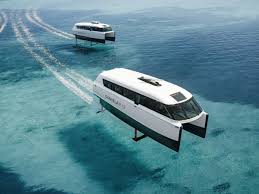
This order represents the largest in Candela’s history, with Gustav Hasselskog, CEO and founder of the company, saying: “The P-12 is designed to create zero-emission water transport systems which have significant improvements over traditional water commuting.”
The Candela P-12, set to debut in Stockholm’s public transport in fall 2024, promises to redefine maritime transit. Using computer-guided underwater wings, or hydrofoils, these vessels consume 80 percent less energy than conventional ships of similar size.
“Unlike legacy systems with large, slow, and energy-inefficient conventional ferries, the Candela P-12 is a smaller and faster unit, allowing much more frequent departures and quicker journeys for passengers,” Hasselskog explained.
With a top speed of 25 knots and over two hours of endurance, the P-12 currently holds the title for the fastest and longest-range electric passenger ship.
This combination of speed and efficiency could significantly reduce commute times within NEOM’s ambitious urban layout.
A life cycle analysis by the KTH Royal Institute of Technology in Stockholm revealed that a P-12 vessel would emit 97.5 percent less CO2 during its lifetime compared to a conventional diesel vessel of the same size. This aligns with NEOM’s vision of sustainable urban development.
The hydrofoil technology also promises enhanced passenger comfort.
“Passengers will fly smoothly over the Red Sea, as the P-12’s digital flight control system balances the ship 100 times per second by adjusting the hydrofoils’ angle of attack, keeping it stable even in winds and waves,” Hasselskog said.
Moreover, the electric Candela C-POD motors, located in underwater pods, operate with minimal noise and disturbance to marine wildlife.
The negligible wake created by these vessels allows for quicker journeys in areas where conventional ships face speed restrictions due to their disruptive wakes.
The first batch of eight vessels is scheduled for delivery in 2025 and early 2026.
“We’re extremely proud to provide a vessel system designed with both passengers and the environment in mind,” Hasselskog said. “Short waiting times, quick connections, and a very enjoyable experience without taxing the environment with wakes, emissions, and noise will revolutionize how we travel on water.”